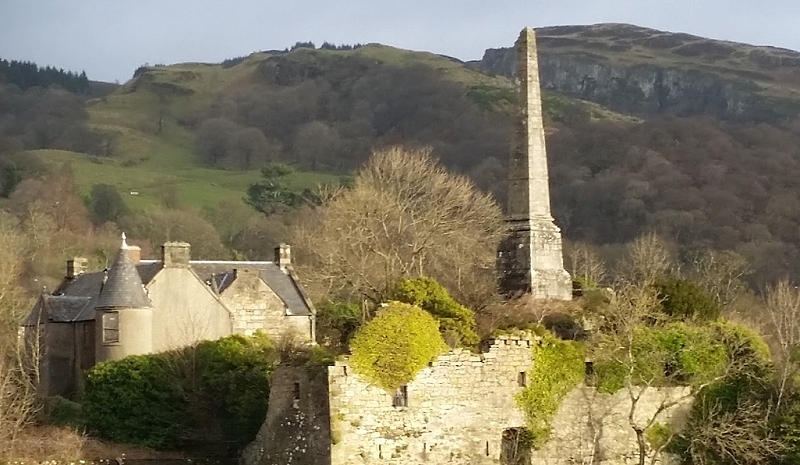
Motto: Si je puis (If I can)
Historic Seat: Dunglass Castle
District: Lennox, Dumbartonshire
Associated Surnames: Cowan, Ingram, King, Macachounich, MacCowan, MacManus
Associated Tartans:
Early Colquhoun Genealogy and History:
(Excerpt from "The Scottish Clans and Their Tartans", James Grant, 1906)
The ancestor of surname of Colquhoun was Humphry Kirkpatrick, in whose favour Malduin, Earl of Lennox, grants charter of the lands of Colchoun in the reign of Alexander II. The first who assumed the surname Colchoun was Ingram, the above Humphry's successor, being so designed in a charter of Luss by Malcolm, Earl of Lennox, to Malcolm, Laird of Luss, confirming John, Laird of Luss, his charter to his son of those lands in the beginning of the reign of King Robert I.
It would appear at one time that there were three branches of this family - Colquhoun of that Ilk, a second Kilpatrick, and a third of Luss. With regard to the Kilpatrick line, it appears that in the reign of Alexander II, Umphredus de Kilpatrick obtained a grant of the lands and barony of Colquhoun in Dumbartonshire, on which occasion he assumed the name and arms of Colquhoun. But there were others of the name in those early times; under David II Gilbert Culquhen, a herald, was forfeited, and lands of Barinneheurie were bestowed on Isabel of Athole. In the same reign a charter was given to Malcolm Culchone of Gask.
Ingram, Humphry, Sir Robert, and Sir Humphry, all Colquhouns of that Ilk and Luss, succeeded each other, till we come to Sir John, who was governor of Dumbarton Castle during the minority of James II. He was lured into ambush by Lauchlan MacLean and other Islesmen, and slain with 120 of his men. His son, Malcolm, predeceased him, and left a son, who succeeded as Sir John Colquhoun, and married a daughter of Lord Boyd. He was a man of ability, and was Comptroller of the Exchequer from 1465 to 1469. He received a grant of the lands of Roseneath. The Castle of Dunglass, the ruins of which abut on the Clyde, and is now the property of Buchanan of Auchintorlie, belonged also to the Colquhouns. In 1474 Sir John was Great Chamberlain of Scotland, and was a commissioner for that futile scheme - a marriage between the Crown Prince of Scotland and Cecily, daughter of Edward IV. In 1477 he was appointed governor for life of Dumbarton Castle, and in the following year was slain by a cannon ball during that siege in which the famous "Mons Meg"1 figured.
He was succeeded by his son, Sir Humphry, who died in 1493, and was succeeded in turn by his son, Sir John, who was knighted by James IV, and obtained, under the Great Seal, grants of several lands and baronies in Dumbartonshire. He died in 1535.
In that year, Patrick and Adam Colquhoun, brothers of the Laird of Luss were tried for the slaughter of William Stirling of Glorat (Pit. Crim. Trials).
Sir Humphry Colquhoun, twelfth Laird of Luss, acquired the Heritable Coronership of Dumbartonshire in 1583. He married Jean, daughter of the Earl of Glencairn, by whom he had no family. He fought the bloody battle of Glen Fruin2, obtained a charter of the ten pounds lands of Donnerbuck.
In April 1608 he wrote to James VI that he had been urged by the Privy Council "to submit with the MacFarlanes" his brother's slaughter, and all other slaughters, "murtheris, heirschips, theiftis, reifs, and oppressions,"3 fire-raising, destruction of houses and woods, etc., and that he had obtained a decree to the amount of "lxxij thousand poindis"4 Scots against them (Scot. Journ. Antiq.) He was made a Baronet of Nova Scotia by Charles I in 1625. He endured many hardships during the English invasion of Scotland, and was mulcted (punished by a fine) in the sum of £2000 sterling by Cromwell, a large sum in those days.
Sir Humphry Colquhoun, seventeeth Laird of Luss, was a member of the Union Parliament, and married a daughter of Houston of that Ilk; by whom he had only a daughter, Anne, who, in 1702, married James Grant of Pluscardine, second son of Grant of that Ilk; and being resolved that the young couple should succeed him in his whole estate and honours, in 1704 he resigned his baronetcy to the Crown, and obtained a new grant, to himself in life-rent5, to his daughter and son-in-law in fee, providing that their heirs should adopt the name and arms of Colquhoun, and that the estates of Grant and Luss should never be conjoined. In the Loch Lomond Expedition against Rob Roy, Sir Humphry was joined by James Grant, with fifty of his surname, "all stately fellows with short hose and belted plaids," says Ray, "each with a well-fixed gun on his shoulder, a handsome targe with a sharp-pointed steel in the centre of it, a claymore by his side, and a pistol or two, with a knife and dirk in his belt." Sir Humphry died in 1715.
James Grant succeeded as Sir James Colquhoun; but his elder brother dying without issue in 1719 he succeeded to the estates of Grant, and resuming that name, was succeeded in the estate of Luss by his second son, Sir Ludovick Grant, who, on the death of his elder brother, unmarried, also succeeded to the estates of Grant, and that of Luss went to his younger brother, James, who was created a Baronet in 1786, and, dying the same year, was succeeded by his son, Sir James, great-grandfather of the present Sir James, fifth Baronet of Colquhoun and Luss.
(End excerpt)
Next page: Clan Cumming
Footnotes:
1 Mons Meg: Mons Meg is a medieval cannon built in 1449, and sent as a gift from Philip the Good, Duke of Burgundy to James II, King of Scots, in 1454. It was used in sieges until the middle of the 16th century, after which it was only used during ceremonial events. Read more about Mons Meg at Wikipedia.
2 The Battle of Glen Fruin (1603): The Battle of Glen Fruin was fought on 7 February 1603 at Glen Fruin, near Loch Lomond in Scotland. It was fought between Clan MacGregor and its allies, and Clan Colquhoun and its allies, after two MacGregor clansmen slaughtered a sheep on Colquhoun land. They were discovered, tried, and sentenced to death. The battle was fought to avenge them, resulting in 140-200 dead. According to tradition this number included a group of clerical students who had assembled to watch the battle and were slaughtered by the MacGregors. Read more about the Battle of Glen Fruin at Wikipedia.
3 murtheris, heirschips, theiftis, reifs, and oppressions: murders, armed raids, thievery, reives, and oppressions
4 lxxij thousand poindis: £72,000
5 life-rent: In Scots law, the right to receive the benefits of a property or other asset for life, without the right to dispose of the property or asset.
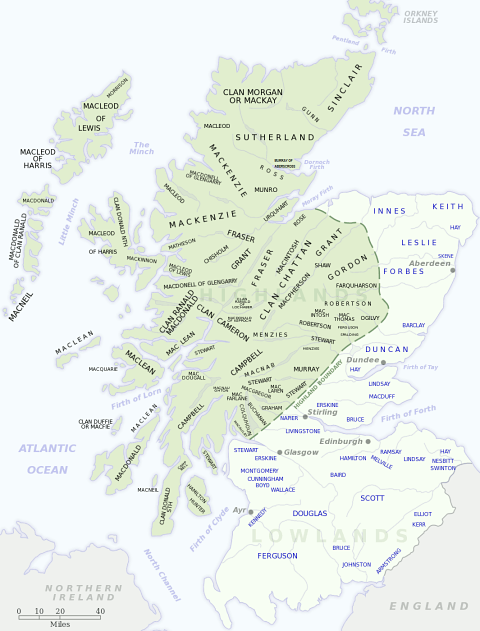
Distribution of Scottish clans and families
View larger map at Wikimedia Commons
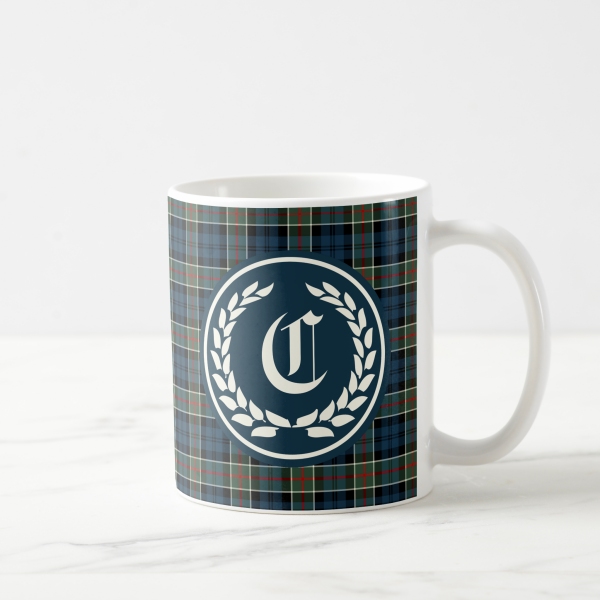
Browse the Clan Colquhoun Tartan Collection with home decor, personal accessories, crafting, paper products, and more.
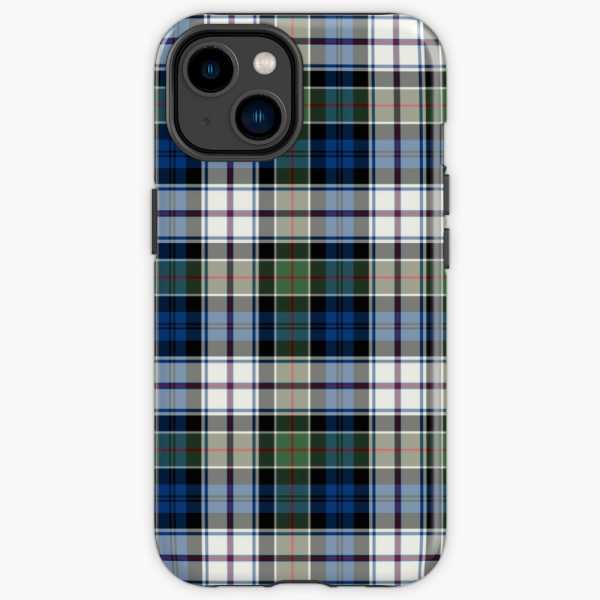
Browse the Clan Colquhoun Dress Tartan Collection with clothing, home decor, accessories, electronics cases, and more.
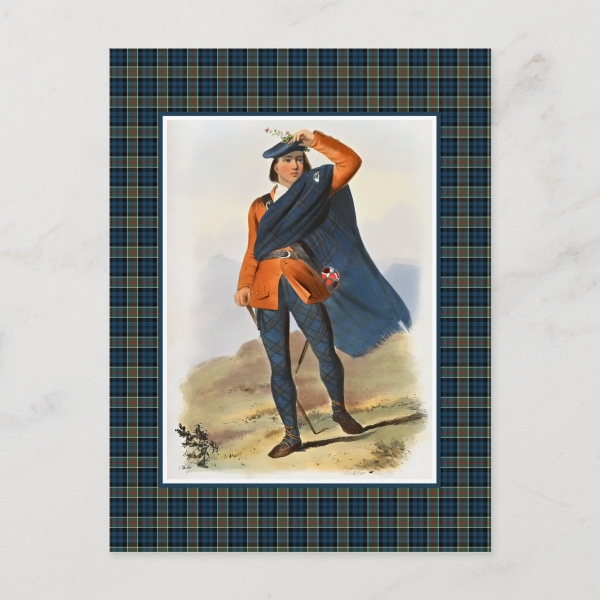
Clan Colquhoun Postcard: Digitally cleaned and enhanced vintage illustration with tartan border.